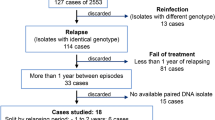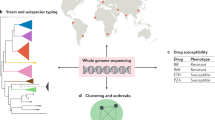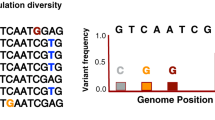Abstract
Tuberculosis poses a global health emergency, which has been compounded by the emergence of drug-resistant Mycobacterium tuberculosis (Mtb) strains. We used whole-genome sequencing to compare the accumulation of mutations in Mtb isolated from cynomolgus macaques with active, latent or reactivated disease. We sequenced 33 Mtb isolates from nine macaques with an average genome coverage of 93% and an average read depth of 117×. Based on the distribution of SNPs observed, we calculated the mutation rates for these disease states. We found a similar mutation rate during latency as during active disease or in a logarithmically growing culture over the same period of time. The pattern of polymorphisms suggests that the mutational burden in vivo is because of oxidative DNA damage. We show that Mtb continues to acquire mutations during disease latency, which may explain why isoniazid monotherapy for latent tuberculosis is a risk factor for the emergence of isoniazid resistance1,2.
This is a preview of subscription content, access via your institution
Access options
Subscribe to this journal
Receive 12 print issues and online access
$209.00 per year
only $17.42 per issue
Buy this article
- Purchase on Springer Link
- Instant access to full article PDF
Prices may be subject to local taxes which are calculated during checkout




Similar content being viewed by others
References
Balcells, M.E., Thomas, S.L., Godfrey-Faussett, P. & Grant, A.D. Isoniazid preventive therapy and risk for resistant tuberculosis. Emerg. Infect. Dis. 12, 744–751 (2006).
Cattamanchi, A. et al. Clinical characteristics and treatment outcomes of patients with isoniazid-monoresistant tuberculosis. Clin. Infect. Dis. 48, 179–185 (2009).
Denver, D.R., Morris, K., Lynch, M. & Thomas, W.K. High mutation rate and predominance of insertions in the Caenorhabditis elegans nuclear genome. Nature 430, 679–682 (2004).
Haag-Liautard, C. et al. Direct estimation of per nucleotide and genomic deleterious mutation rates in Drosophila. Nature 445, 82–85 (2007).
Lynch, M. et al. A genome-wide view of the spectrum of spontaneous mutations in yeast. Proc. Natl. Acad. Sci. USA 105, 9272–9277 (2008).
Capuano, S.V. III et al. Experimental Mycobacterium tuberculosis infection of cynomolgus macaques closely resembles the various manifestations of human M. tuberculosis infection. Infect. Immun. 71, 5831–5844 (2003).
Lin, P.L. et al. Quantitative comparison of active and latent tuberculosis in the cynomolgus macaque model. Infect. Immun. 77, 4631–4642 (2009).
Li, H., Ruan, J. & Durbin, R. Mapping short DNA sequencing reads and calling variants using mapping quality scores. Genome Res. 18, 1851–1858 (2008).
Ioerger, T.R. et al. Genome analysis of multi- and extensively-drug-resistant tuberculosis from KwaZulu-Natal, South Africa. PLoS ONE 4, e7778 (2009).
Hernandez, D., Francois, P., Farinelli, L., Osteras, M. & Schrenzel, J. De novo bacterial genome sequencing: millions of very short reads assembled on a desktop computer. Genome Res. 18, 802–809 (2008).
Gutierrez-Vazquez, J.M. Studies on the rate of growth of mycobacteria. I. Generation time of Mycobacterium tuberculosis on several solid and liquid media and effects exerted by glycerol and malachite green. Am. Rev. Tuberc. 74, 50–58 (1956).
Gill, W.P. et al. A replication clock for Mycobacterium tuberculosis. Nat. Med. 15, 211–214 (2009).
Muñoz-Elías, E.J. et al. Replication dynamics of Mycobacterium tuberculosis in chronically infected mice. Infect. Immun. 73, 546–551 (2005).
Barry, C.E. et al. The spectrum of latent tuberculosis: rethinking the biology and intervention strategies. Nat. Rev. Microbiol. 7, 845–855 (2009).
Lin, P.L. & Flynn, J.L. Understanding latent tuberculosis: a moving target. J. Immunol. 185, 15–22 (2010).
Sarkar, S., Ma, W.T. & Sandri, G.H. On fluctuation analysis: a new, simple and efficient method for computing the expected number of mutants. Genetica 85, 173–179 (1992).
Lang, G.I. & Murray, A.W. Estimating the per-base-pair mutation rate in the yeast Saccharomyces cerevisiae. Genetics 178, 67–82 (2008).
Boshoff, H.I.M., Reed, M.B., Barry, C.E. & Mizrahi, V. DnaE2 polymerase contributes to in vivo survival and the emergence of drug resistance in Mycobacterium tuberculosis. Cell 113, 183–193 (2003).
Werngren, J. & Hoffner, S.E. Drug-susceptible Mycobacterium tuberculosis Beijing genotype does not develop mutation-conferred resistance to rifampin at an elevated rate. J. Clin. Microbiol. 41, 1520–1524 (2003).
Telenti, A. et al. Detection of rifampicin-resistance mutations in Mycobacterium tuberculosis. Lancet 341, 647–650 (1993).
Nathan, C. & Shiloh, M.U. Reactive oxygen and nitrogen intermediates in the relationship between mammalian hosts and microbial pathogens. Proc. Natl. Acad. Sci. USA 97, 8841–8848 (2000).
Ng, V.H., Cox, J.S., Sousa, A.O., MacMicking, J.D. & McKinney, J.D. Role of KatG catalase-peroxidase in mycobacterial pathogenesis: countering the phagocyte oxidative burst. Mol. Microbiol. 52, 1291–1302 (2004).
Sassetti, C.M. & Rubin, E.J. Genetic requirements for mycobacterial survival during infection. Proc. Natl. Acad. Sci. USA 100, 12989–12994 (2003).
Boshoff, H.I., Durbach, S.I. & Mizrahi, V. DNA metabolism in mycobacterium tuberculosis: implications for drug resistance and strain variability. Scand. J. Infect. Dis. 33, 101–105 (2001).
Fenhalls, G. et al. In situ detection of Mycobacterium tuberculosis transcripts in human lung granulomas reveals differential gene expression in necrotic lesions. Infect. Immun. 70, 6330–6338 (2002).
Saint-Ruf, C., Pesut, J., Sopta, M. & Matic, I. Causes and consequences of DNA repair activity modulation during stationary phase in Escherichia coli. Crit. Rev. Biochem. Mol. Biol. 42, 259–270 (2007).
Bjedov, I. et al. Stress-induced mutagenesis in bacteria. Science 300, 1404–1409 (2003).
Cohen, T., Lipsitch, M., Walensky, R.P. & Murray, M. Beneficial and perverse effects of isoniazid preventive therapy for latent tuberculosis infection in HIV–tuberculosis coinfected populations. Proc. Natl. Acad. Sci. USA 103, 7042–7047 (2006).
Perriëns, J.H. et al. Increased mortality and tuberculosis treatment failure rate among human immunodeficiency virus (HIV) seropositive compared with HIV seronegative patients with pulmonary tuberculosis treated with “standard” chemotherapy in Kinshasa, Zaire. Am. Rev. Respir. Dis. 144, 750–755 (1991).
Lee, J., Remold, H.G., Ieong, M.H. & Kornfeld, H. Macrophage apoptosis in response to high intracellular burden of Mycobacterium tuberculosis is mediated by a novel caspase-independent pathway. J. Immunol. 176, 4267–4274 (2006).
Kurtz, S. et al. Versatile and open software for comparing large genomes. Genome Biol. 5, R12 (2004).
Acknowledgements
This work was supported by a New Innovator's Award, DP2 0D001378 from the Director's Office of the National Institute of Health to S.M.F., by a subcontract from National Institute for Allergy and Infectious Diseases (NIAID) U19 AI076217 to S.M.F., by the US National Institutes of Health (NIH) RO1 HL075845 to J.L.F. and by the Bill and Melinda Gates Foundation (J.L.F.). The genome sequencing has been funded in part with federal funds from the National Institute of Allergy and Infectious Disease, US NIH, US Department of Health and Human Services, under contract no. HHSN266200400001C. The project described was supported in part by Award Number U54GM088558 to M.L. from the National Institute of General Medical Sciences. The content is solely the responsibility of the authors and does not necessarily represent the official views of the National Institute of General Medical Sciences or the National Institutes of Health. We thank D. Gurgil and J. Xu of the Enterprise Research IS group at Partners Healthcare for their support and for provision of the HPC facilities and E. Klein for necropsy and pathology of the infected monkeys, as well as the veterinary technical staff for care of the animals. We also thank E. Rubin, C. Sassetti, B. Bloom, T. Rosebrock and B. Aldridge for helpful feedback.
Author information
Authors and Affiliations
Contributions
C.B.F. performed molecular studies, conducted the data analyses, prepared the figures and drafted the manuscript; P.L.L. and J.L.F. conducted the infection of the cynomolgus macaques, determined clinical state and acquired bacterial strains on necropsy; M.R.C. analyzed sequence data and directed validation of SNPs; R.R.S. performed molecular and fluctuation analyses; O.I. oversaw sequencing of isolates sent to Partners Healthcare Center for Personalized Genetic Medicine (PHCPGM); J.G. oversaw sequencing of isolates sent to the Broad Institute; N.M., T.R.I. and J.C.S. oversaw sequencing and analysis of isolates sent to Texas A&M University; M.L. supervised and advised statistical analyses; S.M.F. initiated the project, performed molecular studies, supervised preparation and analysis of the data and drafted the manuscript.
Corresponding author
Ethics declarations
Competing interests
The authors declare no competing financial interests.
Supplementary information
Supplementary Text and Figures
Supplementary Figure 1 and Supplementary Tables 1 and 2. (PDF 190 kb)
Rights and permissions
About this article
Cite this article
Ford, C., Lin, P., Chase, M. et al. Use of whole genome sequencing to estimate the mutation rate of Mycobacterium tuberculosis during latent infection. Nat Genet 43, 482–486 (2011). https://doi.org/10.1038/ng.811
Received:
Accepted:
Published:
Issue Date:
DOI: https://doi.org/10.1038/ng.811
This article is cited by
-
Global-scale GWAS associates a subset of SNPs with animal-adapted variants in M. tuberculosis complex
BMC Medical Genomics (2023)
-
Native microbiome dominates over host factors in shaping the probiotic genetic evolution in the gut
npj Biofilms and Microbiomes (2023)
-
Near-field sensor array with 65-GHz CMOS oscillators can rapidly and comprehensively evaluate drug susceptibility of Mycobacterium
Scientific Reports (2023)
-
Parallel signatures of Mycobacterium tuberculosis and human Y-chromosome phylogeography support the Two Layer model of East Asian population history
Communications Biology (2023)
-
Estimation of the mutation rate of Mycobacterium tuberculosis in cases with recurrent tuberculosis using whole genome sequencing
Scientific Reports (2022)



